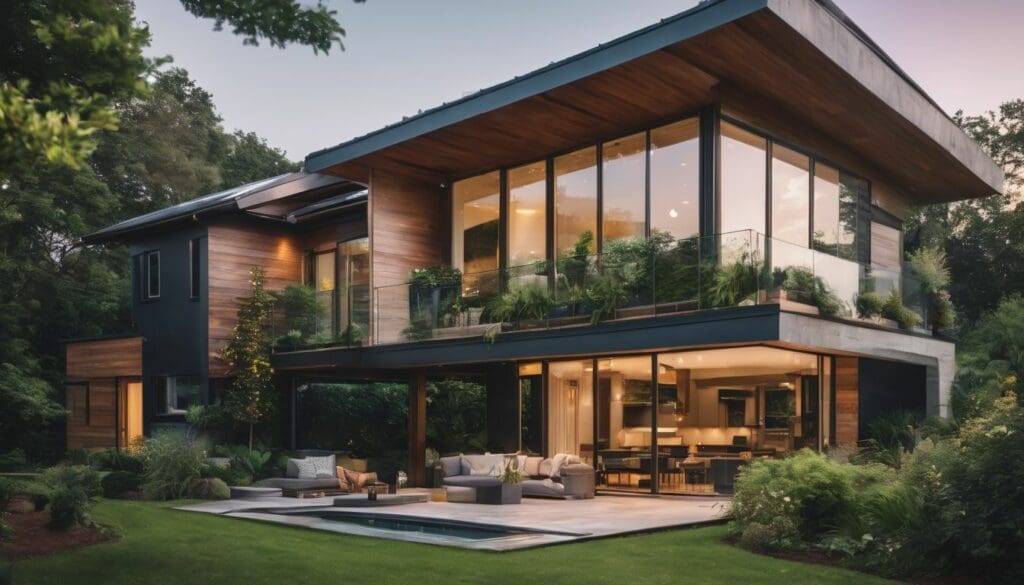Are you on the hunt for practical ways to tread more lightly upon our precious Earth and ease the pressure on your energy expenditures? You’re in good company; many of us have felt the sting of climbing utility bills coupled with a pressing responsibility towards environmental stewardship.
It’s heartening to observe that green buildings can dramatically reduce energy consumption by 24% when measured against conventional structures. Our meticulously compiled guide brims with inventive approaches to crafting not just aesthetically pleasing, but ethically sound homes and workspaces.
Together, let’s embrace these insights and embed sustainability deep within the very walls we inhabit – because taking care of our planet is ultimately about taking care of each other.
Dive in, and let’s chart a course towards a future where green living becomes second nature.
Key Takeaways
- Green buildings significantly reduce environmental impact by using renewable energy sources and sustainable materials, leading to 24% less energy consumption compared to conventional structures.
- Implementing smart technologies and passive design in green constructions enhances natural temperature control, lowering reliance on mechanical systems and reducing energy demands.
- Sustainable building practices in green construction include water conservation, waste reduction, usage of eco-friendly materials like recycled steel or reclaimed wood, and improving indoor air quality for healthier living spaces.
- Energy – efficient lighting, appliances, and machinery play a crucial role in minimising resource use within green buildings while contributing to cost savings through lower utility bills.
- Net positive energy buildings are at the cutting edge of green design; they produce more energy than they consume, promoting sustainability goals by adding clean power back into the grid.
What are Green Buildings?
Green buildings are designed to have a minimal impact on the environment, focusing on energy efficiency and sustainability. They use renewable energy sources and sustainable building materials to reduce their environmental footprint.
Additionally, they often incorporate features like water conservation, waste reduction, and improved indoor air quality.
Definition and concept
We understand green buildings as structures that both respect the environment and use resources wisely, from inception through to demolition. The concept hinges on creating living and working spaces that stand in harmony with nature, reduce waste, and create healthier environments for us.
They are crafted with eco-friendly construction materials like reclaimed wood or recycled steel, which adds an innovative twist to sustainable architecture.
Our goal is to craft buildings that save energy like it’s high-score points. Features such as solar panels or passive solar design help these structures harness renewable energy effectively.
We think of it as playing a strategy game where every choice has long-term impacts: choosing sustainable materials, designing for low environmental impact and aiming for resource-efficient operations pays off by reducing our carbon footprint while promoting energy conservation.
Importance and applications
Green buildings play a crucial role in reducing global energy use and minimising environmental impact. By incorporating energy-efficient appliances, sustainable building materials, and renewable energy integration, green buildings help to lower utility bills and contribute to long-term cost savings.
Furthermore, their eco-conscious design enhances indoor air quality and reduces greenhouse gas emissions which ultimately leads to a healthier living and working environment.
Moreover, the applications of green buildings are diverse, ranging from designing energy-efficient homes with passive design techniques to integrating smart technologies in offices for better energy performance analysis.
With an aim to boost the overall sustainability of cities, green buildings not only reduce carbon footprint but also contribute towards creating resource-efficient structures that align with environmental consciousness.
These constructions hold immense potential for fostering a more sustainable future by embracing low-impact development practices and environmentally conscious construction methods.
Relation to location and EPA programmes
When considering the relation of green buildings to location and EPA programmes, it’s essential to recognise their impact on local communities and environmental policies. The strategic placement of energy-efficient homes and eco-friendly offices contributes to reducing overall energy consumption in urban areas.
Furthermore, these sustainable structures play a crucial role in supporting the Environmental Protection Agency’s initiatives for promoting resource efficiency, waste reduction, and improved indoor air quality within built environments.
By aligning with specific geographical settings and adhering to EPA guidelines, green buildings strive to create a positive environmental footprint while contributing towards sustainable development goals.
Features of Green Buildings
Green Buildings are designed to be energy efficient, conserve water, and reduce waste. They also prioritise indoor air quality and utilise sustainable building materials for a more eco-friendly construction.
Energy efficiency
Designing energy-efficient homes and offices involves integrating smart technologies, such as energy-efficient lighting and machinery, to reduce energy consumption. Utilising renewable energy sources like solar panels and wind turbines further boosts the eco-friendliness of these structures.
Additionally, by strategically implementing passive design strategies and demand reduction techniques during construction, green buildings are able to significantly lower their environmental impact while also contributing to long-term cost savings through reduced utility bills.
In the pursuit of sustainable living, green buildings play a vital role in reducing global energy use and greenhouse gas emissions. They are designed to conserve energy and water while enhancing indoor environments for occupants.
Water conservation
Green buildings focus on water conservation to reduce the strain on local water supplies and decrease overall water usage. By implementing efficient plumbing fixtures, rainwater harvesting systems, and using recycled water for non-potable purposes, green buildings significantly lower their water consumption.
This plays a vital role in creating sustainable structures that minimise environmental impact while promoting resource efficiency. Water conservation not only benefits the environment but also leads to long-term cost savings by reducing utility bills and enhancing overall operational sustainability within homes and offices.
Moving forward from energy-efficient design, let’s delve into sustainable building materials used in green constructions for maximum eco-friendliness.
Sustainable building materials
Sustainable building materials play a crucial role in the construction of green buildings. These materials are more environmentally friendly and resource-efficient, contributing to reduced energy consumption and lower utility bills.
Utilising eco-friendly construction materials such as straw, recycled metal, sheep’s wool, concrete, and compressed earth blocks helps in creating structures that have a low impact on the environment while ensuring long-term cost savings.
Energy-efficient homes and offices benefit from sustainable design by incorporating renewable materials that align with the goal of reducing global energy use and greenhouse gas emissions.
Waste reduction
Green buildings prioritise waste reduction by implementing strategies to minimise construction and operational waste. Through the use of sustainable building materials, such as recycled metal and compressed earth blocks, green buildings aim to reduce environmental impact and lower resource consumption.
Moreover, advanced construction methods in green buildings ensure efficient use of materials, contributing to a significant decrease in overall waste production. By adopting these waste reduction practices, green buildings play a vital role in promoting eco-friendly construction processes and fostering a more sustainable future for our planet.
Additionally, energy-efficient appliances and machinery within green buildings contribute to reducing operational waste by minimising energy consumption. This integration of smart technologies not only enhances the overall efficiency of the building but also significantly reduces the amount of electronic waste produced over time.
Indoor air quality
Improving indoor air quality is crucial in green buildings. The EPA reports that indoor air pollution can be 2 to 5 times higher than outdoor levels, making it a top concern for building design and maintenance.
Poor indoor air quality can lead to health issues such as allergies, respiratory problems, and even asthma attacks.
Green buildings address these concerns through strategic ventilation systems, use of low-emission materials, and regular monitoring of air quality. By reducing harmful pollutants indoors, green buildings create healthier living and working environments for the occupants.
Operation and maintenance
Proper operation and maintenance of green buildings are essential to ensure their continued energy efficiency and sustainability. Regular maintenance of energy-efficient appliances, systems, and building materials helps to optimise performance and prolong their lifespan.
Routine inspections, servicing, and repairs play a crucial role in reducing energy consumption and maintaining the indoor air quality at optimal levels. By incorporating eco-friendly cleaning products and practices, green buildings can uphold their commitment to environmental responsibility.
Efficient operational strategies such as implementing automated controls for lighting, heating, ventilation, and air conditioning systems contribute significantly to energy savings.
Designing Energy-Efficient Homes
We explore smart technologies, passive design, energy-efficient lighting and machinery, renewable energy use and net positive energy buildings. Discover how to make your home more sustainable and eco-friendly!
Smart technologies and construction methods
Builders incorporate smart technologies and construction methods to create energy-efficient homes and offices. Utilising advanced building automation systems, sensors, and controls ensures optimal energy management.
These technologies also encompass the use of eco-friendly materials that are sustainable and resource-efficient. By integrating these smart solutions, green buildings can significantly reduce their environmental impact while maximising energy savings through efficient operations.
Energy-efficient lighting and machinery further enhance the sustainability of green buildings. Incorporating renewable energy sources like solar panels or wind turbines into the construction helps to achieve net positive energy buildings, contributing to a more sustainable future.
Passive design and demand reduction
To further enhance energy efficiency, passive design and demand reduction strategies play a crucial role in green building construction. These methods focus on designing homes and offices to naturally maintain comfortable indoor temperatures without the excessive use of heating or cooling systems.
By leveraging building orientation, insulation, natural ventilation, and shading techniques, passive design reduces the reliance on mechanical HVAC systems, thus curbing energy demand significantly.
Moreover, demand reduction involves implementing smart technologies that monitor and regulate energy usage in real-time, efficiently managing electricity consumption within these eco-conscious structures.
Relying on strategic placement of windows for natural lighting while minimising direct sunlight exposure helps reduce the need for artificial lighting during daylight hours. Employing thermal mass materials in construction aids in maintaining stable indoor temperatures throughout different seasons without overreliance on active heating or cooling systems.
Energy-efficient lighting and machinery
To optimise energy efficiency in homes and offices, incorporating energy-efficient lighting and machinery is essential. LED lights are a prime example of this, using significantly less energy than traditional incandescent bulbs and lasting much longer.
By integrating motion sensor-activated lighting systems, unnecessary usage can be avoided, reducing overall energy consumption. Efficient machinery such as ENERGY STAR-rated appliances also contribute to conserving resources and cutting down on utility bills.
Moreover, the use of smart technologies like programmable thermostats enables precise control over heating and cooling systems, further enhancing energy efficiency. These small yet impactful changes in the choice of lighting and machinery play a crucial role in creating eco-friendly buildings that benefit both the environment and occupants.
Utilising renewable energy
Green buildings are designed to utilise renewable energy sources, such as solar power and wind turbines, to reduce reliance on non-renewable energy. Incorporating these alternative energy sources helps in lowering carbon emissions and reduces the overall environmental impact of the building.
By harnessing renewable energy, green buildings contribute to a more sustainable future while also potentially reducing long-term utility costs for homeowners or businesses.
Furthermore, the use of renewable energy in green buildings aligns with eco-conscious initiatives and encourages a shift towards cleaner and greener construction practices. This approach not only benefits the environment but also promotes resource efficiency and enhances the overall efficiency of homes and offices.
Net positive energy buildings
Net positive energy buildings generate more energy than they consume, contributing excess power back to the grid. They are designed with advanced systems and modern technologies such as solar panels, wind turbines, or geothermal heat pumps to produce surplus energy.
These buildings play a significant role in reducing the overall carbon footprint of cities and helping combat climate change by producing clean renewable energy. Incorporating net positive energy features into homes and offices can lead to long-term cost savings through lower utility bills and make a substantial contribution towards achieving sustainability goals.
Moving on to “Future Developments and Research”, let’s explore how technology is shaping the future of green buildings for even greater efficiency.
Designing Energy-Efficient Offices
The integration of green technologies and energy performance analysis are essential for designing ecoconscious offices. Read more to discover how you can create an energy-efficient workplace that benefits both the environment and your bottom line.
Benefits of location-efficient sites
Location-efficient sites offer numerous advantages for energy-efficient offices. By situating buildings in close proximity to public transportation and amenities, employees can reduce their reliance on personal vehicles, cutting down on greenhouse gas emissions from commuting.
Additionally, location-efficient sites enhance community connectivity and promote a healthier work-life balance by enabling easier access to shops, restaurants, and recreational facilities for employees.
Furthermore, these sites can attract top talent due to their convenient locations and environmental consciousness. Organisations benefit from reduced operational costs as well; with lower demand for parking infrastructure and potential incentives for choosing sustainable locations.
Integration of green technologies
Green technologies seamlessly integrate smart energy-efficient solutions into building design and operations. Energy performance analysis allows for the efficient use of resources, while green roofs and cool roofs help regulate temperature and reduce energy consumption.
These strategies not only contribute to lower utility bills but also enhance indoor air quality, creating healthier living environments for occupants. Utilising eco-friendly appliances and renewable energy sources further reduces carbon footprint and supports sustainable living.
As we delve into the incorporation of green technologies in building design, it’s essential to understand their impact on enhancing environmental sustainability and reducing energy consumption.
This integration promotes resource-efficient structures that benefit both the environment and inhabitants by fostering a healthier, more sustainable way of life.
Energy performance analysis
To evaluate the energy performance of a building, various factors are taken into consideration. These factors include the type and efficiency of lighting and machinery used, as well as the extent to which renewable energy sources are utilised.
Additionally, benchmarking, tracking, and monitoring energy use play a crucial role in analysing and improving a building’s overall energy efficiency. By conducting thorough energy performance analysis, we can identify areas for improvement and implement measures to reduce resource consumption while also decreasing greenhouse gas emissions.
Energy-efficient buildings contribute significantly to reducing global energy use and lessening their environmental impact. Through implementing sustainable building materials, smart technologies during construction, and efficient operation methods post-construction, these structures make vital contributions towards mitigating climate change and creating a more sustainable future.
Use of green roofs and cool roofs
Green roofs and cool roofs are innovative strategies used in the design of energy-efficient buildings. Green roofs, also known as living roofs, are covered with vegetation, providing natural insulation and reducing the urban heat island effect.
They help regulate temperature and absorb rainwater, contributing to improved air quality. On the other hand, cool roofs are designed with materials that reflect sunlight and emit absorbed solar radiation to reduce heat transfer to the building below.
This helps in decreasing energy consumption for cooling during hot weather while extending roof lifespan.
These roofing technologies play a vital role in enhancing building efficiency by mitigating environmental impact and improving energy performance. The use of green roofs and cool roofs fosters sustainable construction practices that align with eco-friendly principles.
Integrating these roofing methods into building design significantly contributes to resource-efficient structures and low-impact development, ultimately benefiting both our environment and communities.
Future Developments and Research
The role of IoT in green buildings will continue to revolutionise the way we design and manage energy-efficient homes and offices, ensuring optimal resource utilisation. Additionally, sustainable building practices will be further explored in relation to environmental justice and the development of net zero buildings.
The role of IoT in green buildings
The Internet of Things (IoT) plays a significant role in green buildings by enabling efficient energy management and environmental monitoring. IoT devices, such as smart thermostats and occupancy sensors, help optimise energy usage by adjusting heating, cooling, and lighting based on real-time data.
These devices also contribute to improving indoor air quality through the continuous monitoring of environmental parameters like temperature and humidity. Furthermore, IoT technology allows for remote building management, enhancing operational efficiency while minimising resource consumption.
By leveraging IoT in green buildings, homeowners and businesses can effectively reduce their carbon footprint while enjoying lower utility costs.
Incorporating IoT into green buildings enables proactive maintenance through real-time data analysis from connected devices. This ensures that equipment operates at maximum efficiency while minimising downtime and repair costs.
Additionally, IoT facilitates the integration of renewable energy sources such as solar panels or wind turbines by providing insights into energy production and distribution within the building.
Sustainable building and environmental justice
Moving from the role of IoT in green buildings, we must also consider sustainable building and environmental justice. Green buildings actively contribute to environmental justice by reducing pollution, contaminant exposure, and promoting healthier living conditions for all.
Embracing eco-friendly construction techniques ensures that communities have access to high-quality homes and offices while minimising negative impacts on the environment. By incorporating energy-efficient appliances, low-impact development practices, and resource-efficient structures into our building designs, we can create a more sustainable future for everyone.
Energy-saving designs and the use of green technology are crucial aspects that underpin sustainable building. Additionally, utilising eco-friendly materials not only reduces carbon footprint but also supports environmental justice by providing safe and healthy living environments.
Net zero buildings
Net zero buildings are an innovative and sustainable approach to construction, aiming to balance the amount of energy a building consumes with the renewable energy it generates. These structures are designed to minimise energy usage through efficient appliances, insulation, and lighting while also harnessing renewable energy sources like solar panels or wind turbines.
By utilising these technologies and practices, net zero buildings have a minimal carbon footprint and play a significant role in reducing greenhouse gas emissions, ultimately contributing to a cleaner and healthier environment for all.
Moving on to the next section – Benchmarking, tracking, and monitoring energy use – we will explore how advancements in technology are revolutionising our ability to optimise building performance for even greater sustainability.
Benchmarking, tracking, and monitoring energy use.
To ensure energy efficiency in green buildings, benchmarking, tracking, and monitoring energy use are essential. These processes help us measure and analyse the consumption of energy within a building, allowing us to identify areas for improvement.
By implementing these measures, we can track our progress towards reducing energy consumption and lowering utility bills. Through regular monitoring, we can also detect any spikes or irregularities in energy use and take corrective actions promptly.
This proactive approach not only benefits the environment but also contributes to long-term cost savings for homeowners and businesses.
In addition to enhancing the sustainability of green buildings, benchmarking, tracking, and monitoring energy use enable us to make informed decisions about incorporating renewable energy sources into our homes and offices.
Conclusion
Designing energy-efficient homes and offices through green buildings is essential for creating a sustainable future. It involves integrating smart technologies, renewable materials, and strategic energy use.
By prioritising eco-friendly construction methods and low-impact development, we can significantly reduce resource consumption and contribute to a healthier environment. Embracing the concept of green buildings will not only lead to long-term cost savings but also play a crucial role in reducing global energy use and carbon footprint.
FAQs
1. What are green buildings?
Green buildings are homes and offices designed to be eco-friendly, focusing on energy-saving designs and using resources efficiently.
2. How do energy-efficient appliances contribute to eco-friendly construction?
Energy-efficient appliances use less power and help reduce the carbon footprint of eco-friendly buildings, playing a big part in creating sustainable homes and workplaces.
3. Why is it important to have resource-efficient structures?
Resource-efficient structures minimise waste, save natural materials, and lower our impact on the environment, making them essential for low-impact development.
4. What benefits come from using green building materials?
Using green building materials helps make our homes energy-efficient while also being kinder to Earth since they often come from sustainable sources or recyclable content.





